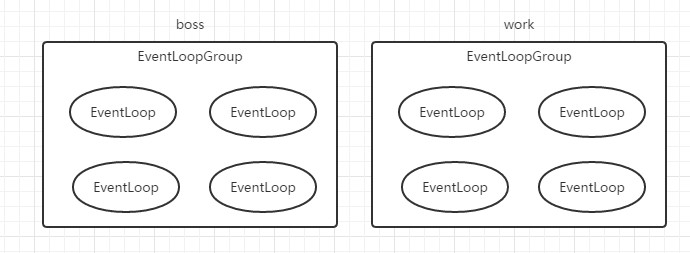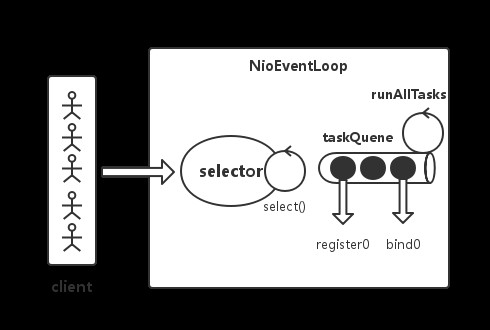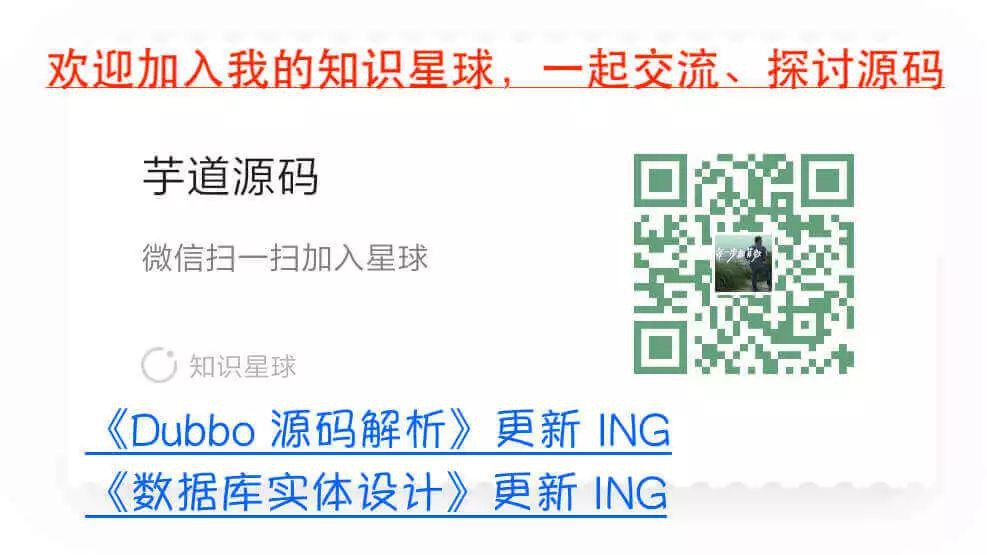點選上方“芋道原始碼”,選擇“置頂公眾號”
技術文章第一時間送達!
原始碼精品專欄
本文主要分析Netty服務端的啟動過程。
Netty是基於Nio實現的,所以也離不開selector、serverSocketChannel、socketChannel和selectKey等,只不過Netty把這些實現都封裝在了底層。
從示例可以看出,一切從ServerBootstrap開始。
ServerBootstrap實體中需要兩個NioEventLoopGroup實體,按照職責劃分成boss和work,有著不同的分工:
1、boss負責請求的accept
2、work負責請求的read、write
NioEventLoopGroup
NioEventLoopGroup主要管理eventLoop的生命週期。
eventLoop是什麼?姑且把它看成是內部的一個處理執行緒,數量預設是處理器個數的兩倍。

NioEventLoopGroup構造方法:
public NioEventLoopGroup() {
this(0);
}
public NioEventLoopGroup(int nThreads) {
this(nThreads, null);
}
public NioEventLoopGroup(int nThreads, ThreadFactory threadFactory) {
this(nThreads, threadFactory, SelectorProvider.provider());
}
public NioEventLoopGroup(
int nThreads, ThreadFactory threadFactory, final SelectorProvider selectorProvider) {
super(nThreads, threadFactory, selectorProvider);
}
MultithreadEventLoopGroup是NioEventLoopGroup的父類,構造方法:
protected MultithreadEventLoopGroup(int nThreads, ThreadFactory threadFactory, Object... args) {
super(nThreads == 0? DEFAULT_EVENT_LOOP_THREADS : nThreads, threadFactory, args);
}
其中 DEFAULT_EVENT_LOOP_THREADS 為處理器數量的兩倍。
MultithreadEventExecutorGroup是核心,管理eventLoop的生命週期,先看看其中幾個變數。
1、children:EventExecutor陣列,儲存eventLoop。
2、chooser:從children中選取一個eventLoop的策略。
構造方法:
protected MultithreadEventExecutorGroup(int nThreads, ThreadFactory threadFactory, Object... args) {
if (nThreads <= 0) {
throw new IllegalArgumentException(String.format("nThreads: %d (expected: > 0)", nThreads));
}
if (threadFactory == null) {
threadFactory = newDefaultThreadFactory();
}
children = new SingleThreadEventExecutor[nThreads];
if (isPowerOfTwo(children.length)) {
chooser = new PowerOfTwoEventExecutorChooser();
} else {
chooser = new GenericEventExecutorChooser();
}
for (int i = 0; i < nThreads; i ++) {
boolean success = false;
try {
children[i] = newChild(threadFactory, args);
success = true;
} catch (Exception e) {
// TODO: Think about if this is a good exception type
throw new IllegalStateException("failed to create a child event loop", e);
} finally {
if (!success) {
for (int j = 0; j < i; j ++) {
children[j].shutdownGracefully();
}
for (int j = 0; j < i; j ++) {
EventExecutor e = children[j];
try {
while (!e.isTerminated()) {
e.awaitTermination(Integer.MAX_VALUE, TimeUnit.SECONDS);
}
} catch (InterruptedException interrupted) {
Thread.currentThread().interrupt();
break;
}
}
}
}
}
final FutureListener1、根據陣列的大小,採用不同策略初始化chooser,如果大小為2的冪次方,則採用PowerOfTwoEventExecutorChooser,否則使用GenericEventExecutorChooser。
其中判斷一個數是否是2的冪次方的方法,覺得很贊。
private static boolean isPowerOfTwo(int val) {
return (val & -val) == val;
}
2、newChild方法多載,初始化EventExecutor時,實際執行的是NioEventLoopGroup中的newChild方法,所以children元素的實際型別為NioEventLoop。
接下去看看NioEventLoop類。
NioEventLoop
每個eventLoop會維護一個selector和taskQueue,負責處理客戶端請求和內部任務,如ServerSocketChannel註冊和ServerSocket系結等。

NioEventLoop構造方法:
NioEventLoop(NioEventLoopGroup parent, ThreadFactory threadFactory, SelectorProvider selectorProvider) {
super(parent, threadFactory, false);
if (selectorProvider == null) {
throw new NullPointerException("selectorProvider");
}
provider = selectorProvider;
selector = openSelector();
}
當看到 selector = openSelector() 時,有沒有覺得親切了許多,這裡先不管 selector,看看SingleThreadEventLoop類。
SingleThreadEventLoop是NioEventLoop的父類,構造方法:
protected SingleThreadEventLoop(EventLoopGroup parent, ThreadFactory threadFactory, boolean addTaskWakesUp) {
super(parent, threadFactory, addTaskWakesUp);
}
啥事都沒做…
繼續看SingleThreadEventLoop的父類SingleThreadEventExecutor
從類名上可以看出,這是一個只有一個執行緒的執行緒池, 先看看其中的幾個變數:
1、state:執行緒池當前的狀態
2、taskQueue:存放任務的佇列
3、thread:執行緒池維護的唯一執行緒
4、scheduledTaskQueue:定義在其父類AbstractScheduledEventExecutor中,用以儲存延遲執行的任務。
…
構造方法:
protected SingleThreadEventExecutor(EventExecutorGroup parent, ThreadFactory threadFactory, boolean addTaskWakesUp) {
if (threadFactory == null) {
throw new NullPointerException("threadFactory");
}
this.parent = parent;
this.addTaskWakesUp = addTaskWakesUp;
thread = threadFactory.newThread(new Runnable() {
@Override
public void run() {
boolean success = false;
updateLastExecutionTime();
try {
SingleThreadEventExecutor.this.run();
success = true;
} catch (Throwable t) {
logger.warn("Unexpected exception from an event executor: ", t);
} finally {
for (;;) {
int oldState = STATE_UPDATER.get(SingleThreadEventExecutor.this);
if (oldState >= ST_SHUTTING_DOWN || STATE_UPDATER.compareAndSet(
SingleThreadEventExecutor.this, oldState, ST_SHUTTING_DOWN)) {
break;
}
}
// Check if confirmShutdown() was called at the end of the loop.
if (success && gracefulShutdownStartTime == 0) {
logger.error(
"Buggy " + EventExecutor.class.getSimpleName() + " implementation; " +
SingleThreadEventExecutor.class.getSimpleName() + ".confirmShutdown() must be called " +
"before run() implementation terminates.");
}
try {
// Run all remaining tasks and shutdown hooks.
for (;;) {
if (confirmShutdown()) {
break;
}
}
} finally {
try {
cleanup();
} finally {
STATE_UPDATER.set(SingleThreadEventExecutor.this, ST_TERMINATED);
threadLock.release();
if (!taskQueue.isEmpty()) {
logger.warn(
"An event executor terminated with " +
"non-empty task queue (" + taskQueue.size() + ')');
}
terminationFuture.setSuccess(null);
}
}
}
}
});
threadProperties = new DefaultThreadProperties(thread);
taskQueue = newTaskQueue();
}
程式碼很長,內容很簡單:
1、初始化一個執行緒,併在執行緒內部執行NioEventLoop類的run方法,當然這個執行緒不會立刻執行。
2、使用LinkedBlockingQueue類初始化taskQueue。
到目前為止,相關的處理執行緒已經初始化完成。
ServerBootstrap
透過serverBootstrap.bind(port)啟動服務,過程如下:
/**
* Create a new {@link Channel} and bind it.
*/
public ChannelFuture bind() {
validate();
SocketAddress localAddress = this.localAddress;
if (localAddress == null) {
throw new IllegalStateException("localAddress not set");
}
return doBind(localAddress);
}

doBind實現如下
private ChannelFuture doBind(final SocketAddress localAddress) {
final ChannelFuture regFuture = initAndRegister();
final Channel channel = regFuture.channel();
if (regFuture.cause() != null) {
return regFuture;
}
if (regFuture.isDone()) {
// At this point we know that the registration was complete and successful.
ChannelPromise promise = channel.newPromise();
doBind0(regFuture, channel, localAddress, promise);
return promise;
} else {
// Registration future is almost always fulfilled already, but just in case it's not.
final PendingRegistrationPromise promise = new PendingRegistrationPromise(channel);
regFuture.addListener(new ChannelFutureListener() {
@Override
public void operationComplete(ChannelFuture future) throws Exception {
Throwable cause = future.cause();
if (cause != null) {
// Registration on the EventLoop failed so fail the ChannelPromise directly to not cause an
// IllegalStateException once we try to access the EventLoop of the Channel.
promise.setFailure(cause);
} else {
// Registration was successful, so set the correct executor to use.
// See https://github.com/netty/netty/issues/2586
promise.executor = channel.eventLoop();
}
doBind0(regFuture, channel, localAddress, promise);
}
});
return promise;
}
}
1、方法initAndRegister傳回一個ChannelFuture實體regFuture,透過regFuture可以判斷initAndRegister執行結果。
2、如果regFuture.isDone()為true,說明initAndRegister已經執行完,則直接執行doBind0進行socket系結。
3、否則regFuture新增一個ChannelFutureListener監聽,當initAndRegister執行完成時,呼叫operationComplete方法並執行doBind0進行socket系結。
所以只有當initAndRegister操作結束之後才能進行bind操作。
initAndRegister實現
final ChannelFuture initAndRegister() {
final Channel channel = channelFactory().newChannel();
try {
init(channel);
} catch (Throwable t) {
channel.unsafe().closeForcibly();
// as the Channel is not registered yet we need to force the usage of the GlobalEventExecutor
return new DefaultChannelPromise(channel, GlobalEventExecutor.INSTANCE).setFailure(t);
}
ChannelFuture regFuture = group().register(channel);
if (regFuture.cause() != null) {
if (channel.isRegistered()) {
channel.close();
} else {
channel.unsafe().closeForcibly();
}
}
return regFuture;
}
1、負責建立服務端的NioServerSocketChannel實體
2、為NioServerSocketChannel的pipeline新增handler
3、註冊NioServerSocketChannel到selector
大部分的過程和NIO中類似。
NioServerSocketChannel
對Nio的ServerSocketChannel和SelectionKey進行了封裝。
構造方法:
public NioServerSocketChannel() {
this(newSocket(DEFAULT_SELECTOR_PROVIDER));
}
private static ServerSocketChannel newSocket(SelectorProvider provider) {
try {
return provider.openServerSocketChannel();
} catch (IOException e) {
throw new ChannelException(
"Failed to open a server socket.", e);
}
}
public NioServerSocketChannel(ServerSocketChannel channel) {
super(null, channel, SelectionKey.OP_ACCEPT);
config = new NioServerSocketChannelConfig(this, javaChannel().socket());
}
1、方法newSocket利用 provider.openServerSocketChannel() 生成Nio中的ServerSocketChannel物件。
2、設定SelectionKey.OP_ACCEPT事件。
AbstractNioMessageChannel構造方法
protected AbstractNioMessageChannel(Channel parent, SelectableChannel ch, int readInterestOp) {
super(parent, ch, readInterestOp);
}
啥也沒做…
AbstractNioChannel構造方法
protected AbstractNioChannel(Channel parent, SelectableChannel ch, int readInterestOp) {
super(parent);
this.ch = ch;
this.readInterestOp = readInterestOp;
try {
ch.configureBlocking(false);
} catch (IOException e) {
try {
ch.close();
} catch (IOException e2) {
if (logger.isWarnEnabled()) {
logger.warn(
"Failed to close a partially initialized socket.", e2);
}
}
throw new ChannelException("Failed to enter non-blocking mode.", e);
}
}
設定當前ServerSocketChannel為非阻塞通道。
AbstractChannel構造方法
protected AbstractChannel(Channel parent) {
this.parent = parent;
unsafe = newUnsafe();
pipeline = new DefaultChannelPipeline(this);
}
1、初始化unsafe,這裡的Unsafe並非是jdk中底層Unsafe類,用來負責底層的connect、register、read和write等操作。
2、初始化pipeline,每個Channel都有自己的pipeline,當有請求事件發生時,pipeline負責呼叫相應的hander進行處理。
unsafe和pipeline的具體實現原理會在後續進行分析。
回到ServerBootstrap的init(Channel channel)方法,新增handler到channel的pipeline中。
void init(Channel channel) throws Exception {
final Map, Object> options = options();
synchronized (options) {
channel.config().setOptions(options);
}
final Map, Object> attrs = attrs();
synchronized (attrs) {
for (Entry, Object> e: attrs.entrySet()) {
@SuppressWarnings("unchecked")
AttributeKey key = (AttributeKey) e.getKey();
channel.attr(key).set(e.getValue());
}
}
ChannelPipeline p = channel.pipeline();
final EventLoopGroup currentChildGroup = childGroup;
final ChannelHandler currentChildHandler = childHandler;
final Entry, Object>[] currentChildOptions;
final Entry, Object>[] currentChildAttrs;
synchronized (childOptions) {
currentChildOptions = childOptions.entrySet().toArray(newOptionArray(childOptions.size()));
}
synchronized (childAttrs) {
currentChildAttrs = childAttrs.entrySet().toArray(newAttrArray(childAttrs.size()));
}
p.addLast(new ChannelInitializer() {
@Override
public void initChannel(Channel ch) throws Exception {
ChannelPipeline pipeline = ch.pipeline();
ChannelHandler handler = handler();
if (handler != null) {
pipeline.addLast(handler);
}
pipeline.addLast(new ServerBootstrapAcceptor(
currentChildGroup, currentChildHandler, currentChildOptions, currentChildAttrs));
}
});
}
1、設定channel的options和attrs。
2、在pipeline中新增一個ChannelInitializer物件。
init執行完,需要把當前channel註冊到EventLoopGroup。
其實最終目的是為了實現Nio中把ServerSocket註冊到selector上,這樣就可以實現client請求的監聽了。看看Netty中是如何實現的:
public ChannelFuture register(Channel channel, ChannelPromise promise) {
return next().register(channel, promise);
}
public EventLoop next() {
return (EventLoop) super.next();
}
public EventExecutor next() {
return children[Math.abs(childIndex.getAndIncrement() % children.length)];
}
因為EventLoopGroup中維護了多個eventLoop,next方法會呼叫chooser策略找到下一個eventLoop,並執行eventLoop的register方法進行註冊。
public ChannelFuture register(final Channel channel, final ChannelPromise promise) {
...
channel.unsafe().register(this, promise);
return promise;
}
channel.unsafe()是什麼?
NioServerSocketChannel初始化時,會建立一個NioMessageUnsafe實體,用於實現底層的register、read、write等操作。
eventLoop.execute(new Runnable() {
@Override
public void run() {
register0(promise);
}
});
private void register0(ChannelPromise promise) {
try {
if (!ensureOpen(promise)) {
return;
}
Runnable postRegisterTask = doRegister();
registered = true;
promise.setSuccess();
pipeline.fireChannelRegistered();
if (postRegisterTask != null) {
postRegisterTask.run();
}
if (isActive()) {
pipeline.fireChannelActive();
}
} catch (Throwable t) {
// Close the channel directly to avoid FD leak.
closeForcibly();
if (!promise.tryFailure(t)) {
}
closeFuture.setClosed();
}
}
public void execute(Runnable task) {
if (task == null) {
throw new NullPointerException("task");
}
boolean inEventLoop = inEventLoop();
if (inEventLoop) {
addTask(task);
} else {
startThread();
addTask(task);
if (isShutdown() && removeTask(task)) {
reject();
}
}
if (!addTaskWakesUp) {
wakeup(inEventLoop);
}
}
1、register0方法提交到eventLoop執行緒池中執行,這個時候會啟動eventLoop中的執行緒。
2、方法doRegister()才是最終Nio中的註冊方法,方法javaChannel()獲取ServerSocketChannel。
protected Runnable doRegister() throws Exception {
boolean selected = false;
for (;;) {
try {
selectionKey = javaChannel().register(eventLoop().selector, 0, this);
return null;
} catch (CancelledKeyException e) {
if (!selected) {
// Force the Selector to select now as the "canceled" SelectionKey may still be
// cached and not removed because no Select.select(..) operation was called yet.
eventLoop().selectNow();
selected = true;
} else {
// We forced a select operation on the selector before but the SelectionKey is still cached
// for whatever reason. JDK bug ?
throw e;
}
}
}
}
ServerSocketChannel註冊完之後,通知pipeline執行fireChannelRegistered方法,pipeline中維護了handler連結串列,透過遍歷連結串列,執行InBound型別handler的channelRegistered方法,最終執行init中新增的ChannelInitializer handler。
public final void channelRegistered(ChannelHandlerContext ctx)
throws Exception {
boolean removed = false;
boolean success = false;
try {
initChannel((C) ctx.channel());
ctx.pipeline().remove(this);
removed = true;
ctx.fireChannelRegistered();
success = true;
} catch (Throwable t) {
logger.warn("Failed to initialize a channel. Closing: " + ctx.channel(), t);
} finally {
if (!removed) {
ctx.pipeline().remove(this);
}
if (!success) {
ctx.close();
}
}
}
1、initChannel方法最終把ServerBootstrapAcceptor新增到ServerSocketChannel的pipeline,負責accept客戶端請求。
2、在pipeline中刪除對應的handler。
3、觸發fireChannelRegistered方法,可以自定義handler的channelRegistered方法。
到目前為止,ServerSocketChannel完成了初始化並註冊到seletor上,啟動執行緒執行selector.select()方法準備接受客戶端請求。
細心的同學已經發現,ServerSocketChannel的socket還未系結到指定埠,那麼這一塊Netty是如何實現的?
Netty把註冊操作放到eventLoop中執行。
private static void doBind0(
final ChannelFuture regFuture,
final Channel channel,
final SocketAddress localAddress,
final ChannelPromise promise) {
channel.eventLoop().execute(new Runnable() {
@Override
public void run() {
if (regFuture.isSuccess()) {
channel.bind(localAddress, promise)
.addListener(ChannelFutureListener.CLOSE_ON_FAILURE);
} else {
promise.setFailure(regFuture.cause());
}
}
});
}
public ChannelFuture bind(SocketAddress localAddress, ChannelPromise promise) {
return pipeline.bind(localAddress, promise);
}
@Override
public ChannelFuture bind(SocketAddress localAddress, ChannelPromise promise) {
return tail.bind(localAddress, promise);
}
@Override
public ChannelFuture bind(SocketAddress localAddress, ChannelPromise promise) {
if (localAddress == null) {
throw new NullPointerException("localAddress");
}
validatePromise(promise, false);
return findContextOutbound().invokeBind(localAddress, promise);
}
private ChannelFuture invokeBind(final SocketAddress localAddress, final ChannelPromise promise) {
EventExecutor executor = executor();
if (executor.inEventLoop()) {
invokeBind0(localAddress, promise);
} else {
executor.execute(new Runnable() {
@Override
public void run() {
invokeBind0(localAddress, promise);
}
});
}
return promise;
}
private void invokeBind0(SocketAddress localAddress, ChannelPromise promise) {
try {
((ChannelOutboundHandler) handler()).bind(this, localAddress, promise);
} catch (Throwable t) {
notifyOutboundHandlerException(t, promise);
}
}
@Override
public void bind(
ChannelHandlerContext ctx, SocketAddress localAddress, ChannelPromise promise)
throws Exception {
unsafe.bind(localAddress, promise);
}
最終由unsafe實現埠的bind操作。
public final void bind(final SocketAddress localAddress, final ChannelPromise promise) {
if (!ensureOpen(promise)) {
return;
}
try {
boolean wasActive = isActive();
...
doBind(localAddress);
promise.setSuccess();
if (!wasActive && isActive()) {
pipeline.fireChannelActive();
}
} catch (Throwable t) {
promise.setFailure(t);
closeIfClosed();
}
}
protected void doBind(SocketAddress localAddress) throws Exception {
javaChannel().socket().bind(localAddress, config.getBacklog());
}
bind完成後,且ServerSocketChannel也已經註冊完成,則觸發pipeline的fireChannelActive方法,所以在這裡可以自定義fireChannelActive方法,預設執行tail的fireChannelActive。
@Override
public ChannelPipeline fireChannelActive() {
head.fireChannelActive();
if (channel.config().isAutoRead()) {
channel.read();
}
return this;
}
channel.read()方法會觸發pipeline的行為:
@Override
public Channel read() {
pipeline.read();
return this;
}
@Override
public ChannelPipeline read() {
tail.read();
return this;
}
@Override
public ChannelHandlerContext read() {
findContextOutbound().invokeRead();
return this;
}
private void invokeRead() {
EventExecutor executor = executor();
if (executor.inEventLoop()) {
invokeRead0();
} else {
Runnable task = invokeRead0Task;
if (task == null) {
invokeRead0Task = task = new Runnable() {
@Override
public void run() {
invokeRead0();
}
};
}
executor.execute(task);
}
}
private void invokeRead0() {
try {
((ChannelOutboundHandler) handler()).read(this);
} catch (Throwable t) {
notifyHandlerException(t);
}
}
最終會在pipeline中找到handler執行read方法,預設是head。
至此為止,server已經啟動完成。

目前在知識星球(https://t.zsxq.com/2VbiaEu)更新瞭如下 Dubbo 原始碼解析如下:
01. 除錯環境搭建
02. 專案結構一覽
03. API 配置(一)之應用
04. API 配置(二)之服務提供者
05. API 配置(三)之服務消費者
06. 屬性配置
07. XML 配置
08. 核心流程一覽
…
一共 60 篇++
 知識星球
知識星球